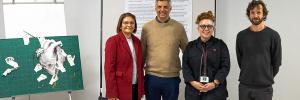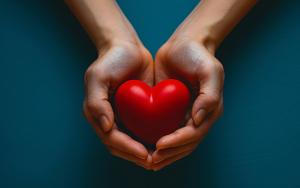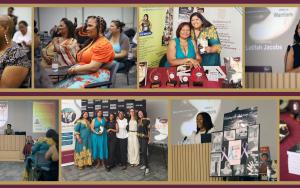
Prof Karin Baatjes (FMHS Vice Dean: Learning and Teaching) with Prof Faadiel Essop, Prof Kathryn Smith and Jonah Sack.
HeartWorks: Fine arts and biomedical students reconsider the human heart
- The ‘HeartWorks: Science Meets Art’ exhibition was held in September at the Medical Morphology Learning Centre at SU's Tygerberg Campus.
- The exhibition, which was organised by the Centre for Cardio-metabolic Research in Africa, called on Fine Arts and Biomedical students to work together to “creatively reconsider” the heart in all its forms and functions.
- Key to the exercise was the invitation to reflect on the heart “both scientifically and emotionally”.
When thinking about the human heart, how can artists represent this multi-faceted organ to include all its complexities? Can art represent the heart both scientifically and emotionally - as an organ of physiology and anatomy, but also as a symbol of human emotion, culture, and lived experience?
These were some of the questions posed in the ‘HeartWorks: Science Meets Art’ exhibition, held in September at the Medical Morphology Learning Centre (MMLC) in the Biomedical Research Institute (BMRI) on Stellenbosch University’s (SU) Tygerberg Campus. The exhibition, which was organised by the Centre for Cardio-metabolic Research in Africa (CARMA), called on Fine Arts and Biomedical students to work together to “creatively reconsider” the heart in all its forms and functions. Key to the exercise was the invitation to reflect on the heart “both scientifically and emotionally”.
Facilitated by Prof Faadiel Essop (CARMA director), and Prof Kathryn Smith and Jonah Sack from the Department of Visual Arts, the exhibition considered what happens when art and science come together.
Taking inspiration from the heart and other human specimens housed in the newly launched MMLC, students looked at how art can “translate the heart and map its connections”. They created artworks which depicted not only the biological structure of the heart but also “the profound feelings, memories, and human stories that such specimens evoke,” Essop said in an interview.
Students used a range of methods – from drawing, to sculpture, to animation and sonic installations, to explore the “aesthetic, functional, and emotional dimensions of the heart – and to contemplate on how to think about, and represent in a diverse and inclusive way, the epidemiological and physiological aspects of heart disease, and the structural legacies of the role of medicine as a tool to advance colonialism. They drew inspiration from the historical intersections of art and science in understanding anatomy.”
The aim of the initiative was to encourage fine arts and biomedical students to reconsider the heart and human physiology and anatomy, and to challenge preconceptions of how knowledge is produced across disciplines.
Students began the process by using ink and other tools to sketch artworks about the heart, before visiting the MMLC to see the ‘real’ heart specimens. Then, using the body specimens as inspiration, they developed their artworks into drawings, sculptures, installations and animations that went way beyond the biological representations.
They also engaged with fellow students from the Divisions of Medical Physiology, and Molecular Biology and Human Genetics. Essop said, for both students and educators, it was a confronting and transformative experience to see specimens outside of a medical lens and reconnect with the humanity of the donors.
“Seeing real human specimens, such as brains, skulls and bones, human torsos, hands, arms, legs, and even foetuses, was an out-of-body experience; some of my classmates were uncomfortable and had to step outside. I was drawn to the human hips, and this is where the idea for my final work started,” said Fine Arts student Sarah Oosthuizen. “The heart does more than merely pump blood around the body. It can be the bearer of anxiety and over-exertion (heart palpitations). This made me think, where else does the body store stress and trauma?”
For another student, Carmen Andrag, it was “a process in which I unexpectedly, and weirdly felt a sense of responsibility and purpose that I’d never encountered before while drawing.”
Aimee de Villiers said she “explored the rising emotions induced within me when being exposed to death so literally at the MMLC, especially the phrase, ‘hands grow from the heart’. As an embryo, our hands and feet grow outwards, from our centre and heart, so we expand outwardly, opening like flowers.”
Essop said the “amazingly successful” exhibition was an important example of bringing the different disciplines in art, science and medicine, together to create “a more complete picture of human experience.”
He noted that where science seeks understanding through analysis, art provides interpretation and emotion, and together they expand the horizons of learning.
“A key aim was to promote creativity and critical thinking in our students at SU’s Faculty of Medicine and Health Sciences. To engage in another discipline to see what they could learn in terms of cultivating humanity, and to gain alternative perspectives in terms of creativity, which can stimulate innovation.”
Smith and Sack said the practise for art students of engaging with scientific material that were so “deeply human” held immense value.
Following on from what was considered a “profound integration of art and anatomy”, plans are afoot to repeat this exercise in collaboration and joint learning, Essop said, adding that when art and science come together, education becomes “deeper, more inclusive, and profoundly moving.”



